
views
Composing Your Email
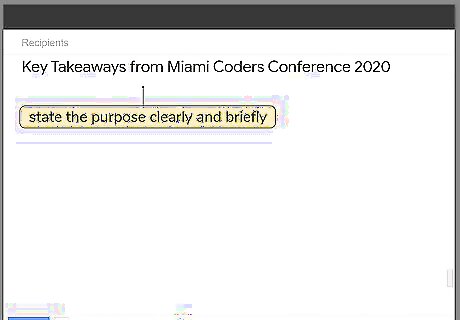
State the purpose of your email clearly and briefly in the subject line. Write a subject line that gives your audience a clear preview of what to expect when they open your email. Try to keep the length of the subject line to about 7 words.Tip: If you want people to read your knowledge sharing email within a certain timeframe, include a date in the subject line. For example, you could put “Industry Advancements to Discuss in Meeting August 2.” For example, if you want to share the knowledge you gained while attending a coding conference, you could make the subject line something like: “Key Takeaways from Miami Coders Conference 2020.” Emails with vague or overly long subject lines are much less likely to get opened. Steer away from short subject lines of just 1-2 words that don’t effectively state what the email is about.
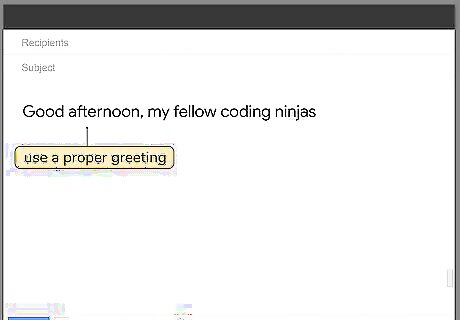
Begin the email with a greeting directed at your specific audience. Make it personal! Think about the audience you plan to send your knowledge sharing email to and choose a greeting with an appropriate level of formality. Make the greeting inclusive of everyone who will receive the email. For example, if you’re sending the email out to a small team of programmers who you work with closely and know well, you could start the email with something super casual and friendly like: “Good afternoon, my fellow coding ninjas.” If you’re sending a knowledge sharing email to higher ups or some kind of group that contains individuals you don’t know personally, you might choose a more formal greeting along the lines of: “Dear members of the executive board,” or “Good morning, marketing team.” If you are sharing knowledge with just 1 or 2 people, you can address them by name in your email’s greeting. When in doubt, you can just use something generic like: “Hello, everyone,” or “Good afternoon.”
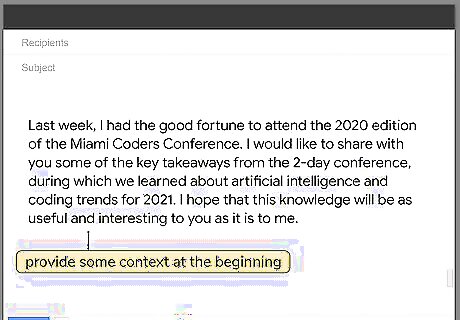
Write some brief background or context at the beginning of the email. Start off with a short paragraph, right underneath your greeting, that explains what you will be sharing in your email. This will give readers more context for what they are about to read than the subject line. For instance, if you’re sharing learnings from a coding conference, you can write something like: “Last week, I had the good fortune to attend the 2020 edition of the Miami Coders Conference. I would like to share with you some of the key takeaways from the 2-day conference, during which we learned about artificial intelligence and coding trends for 2021. I hope that this knowledge will be as useful and interesting to you as it is to me.”

Break up the body of the email into sections. Divide the main points you want to share into cohesive sections, so it’s easier to follow and digest. Put headings at the beginning of each section of information to make it clear what the text below is about. Break up long sections into multiple shorter paragraphs to split up the information, instead of just dumping a bunch of info into 1 long text block. Make sure each one of your paragraphs contains related points. If you are starting a new thought, start writing a new paragraph. For example, if you want to share what you learned about artificial intelligence and coding trends at a recent conference you attended, you could structure your email like this: a section heading that says, “Artificial Intelligence Industry Updates,” then write a few paragraphs about the subject, followed by another section heading that says, “Coding Trends for 2021,” followed by a few more paragraphs. Specify what the outcomes are and what the participants will walk away with. Don't focus solely on the key takeaways, but discuss what the learning outcomes are.
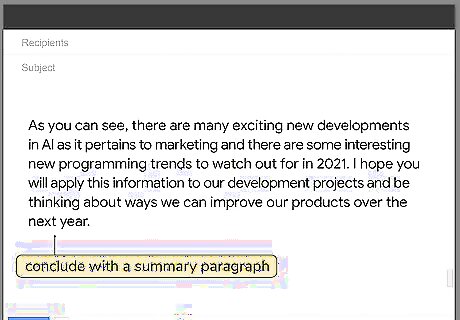
Conclude the body of the email with a summary paragraph and a call to action. Write a short paragraph before your sign off that reiterates some of the main information that your email contained. Let your readers know what you hope they gain from the shared knowledge and include any relevant action items. For example, you can say something like: “As you can see, there are many exciting new developments in AI as it pertains to marketing and there are some interesting new programming trends to watch out for in 2021. I hope you will apply this information to our development projects and be thinking about ways we can improve our products over the next year.” An example of an action item would be something like: “Let’s plan to share some of our thoughts on all of this info in the meeting on Friday. Please come prepared with at least 1 point to discuss.”
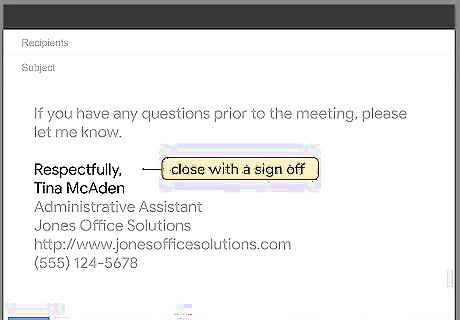
End your email with a sign off followed by your name and title. Choose a sign off that is brief and friendly with an appropriate level of formality for your audience. Include your name and title at the very end, so people know exactly who the email they just read is from, which is especially important if you don’t personally know all the members of your audience. Examples of casual sign offs that work for almost any email are: “Thank you,” “Regards,” and “All the best.” Some more formal sign offs are: “Sincerely,” and “Respectfully yours.” Some ideas for even more casual sign offs, that you might use for an email to people to work with or see every day, are: “See you all tomorrow,” and “Cheers.” If you are sharing knowledge outside of your organization, include the name of your organization after your name and title as well, so people know where you are writing them from.
Making Your Email Reader-Friendly
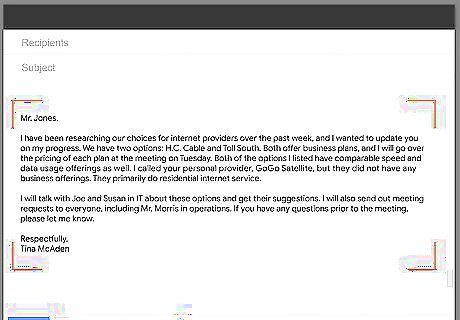
Keep your email as short as possible. Try to include all the information you want to share in as few words as possible. The longer your email is, the less likely the people you want to share your knowledge with are to read the entire thing. If you’re writing about a particularly complex topic, you can always include links to outside sources or attachments to provide more detailed information. That way, those who are interested in what you’re sharing can dive in deeper to the topic. There is no set-in-stone rule for how long a knowledge sharing email should be, and it will depend a lot on the type of information you are sharing and the complexity of the subject. A good rule of thumb is to not write an email longer than you would want to read yourself.

Highlight important information with bullet points or numbered lists. Repeat key pieces of information from your text paragraphs in bullet points or numbered lists. This helps reiterate the knowledge you are sharing and gives readers something to quickly glance at to get some of the main points of your email. For instance, you could make a list with a title like “Top 5 Marketing Trends for 2021” and write out the trends from 1-5 in a numbered list below it. Readers can easily see what the trends are, then read the text of your email if they want more in depth information.
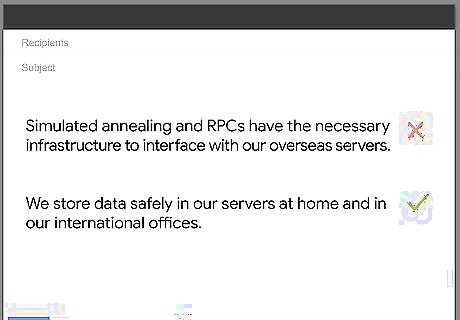
Use simple, easy-to-understand language as much as possible. Avoid using big words and jargon to explain your points unless you absolutely need to. This will make your email much easier to read and understand by a wider audience who are probably not as familiar with the topic you’re writing about as you are.Tip: If you absolutely need to use a word that people might not know to explain a point, provide a definition the first time you use the word in the content of your email. Consider your audience when you’re choosing what language to use, as well. If you’re writing to a small group of programmers, for example, you can probably get away with using more coding jargon in your email than if you’re writing to a varied audience.

Write in a professional tone. Be polite, use proper grammar and punctuation, and choose your words carefully. Avoid writing in a casual tone and don’t use slang or unprofessional language. This will help you come across as professional and knowledgeable in the subject that you are sharing information about. For example, don’t write words in all caps and use exclamation marks sparingly, so you don’t come across like you’re yelling at your audience. Don’t use slang words or phrases like “yo,” “what’s up,” or “y’all,” to name a few.

Stick to standard fonts, characters, and email formatting. Don’t use any fonts or special characters that some systems don’t have. Use a standard system font that is built-in to your email server, stick to using characters that are on a standard keyboard, and don’t mess with the default formatting of your email. This will ensure that virtually anyone who receives your email on a different computer or through a different email server will see exactly what you saw when you wrote your email.










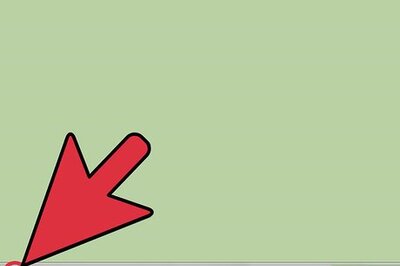





Comments
0 comment